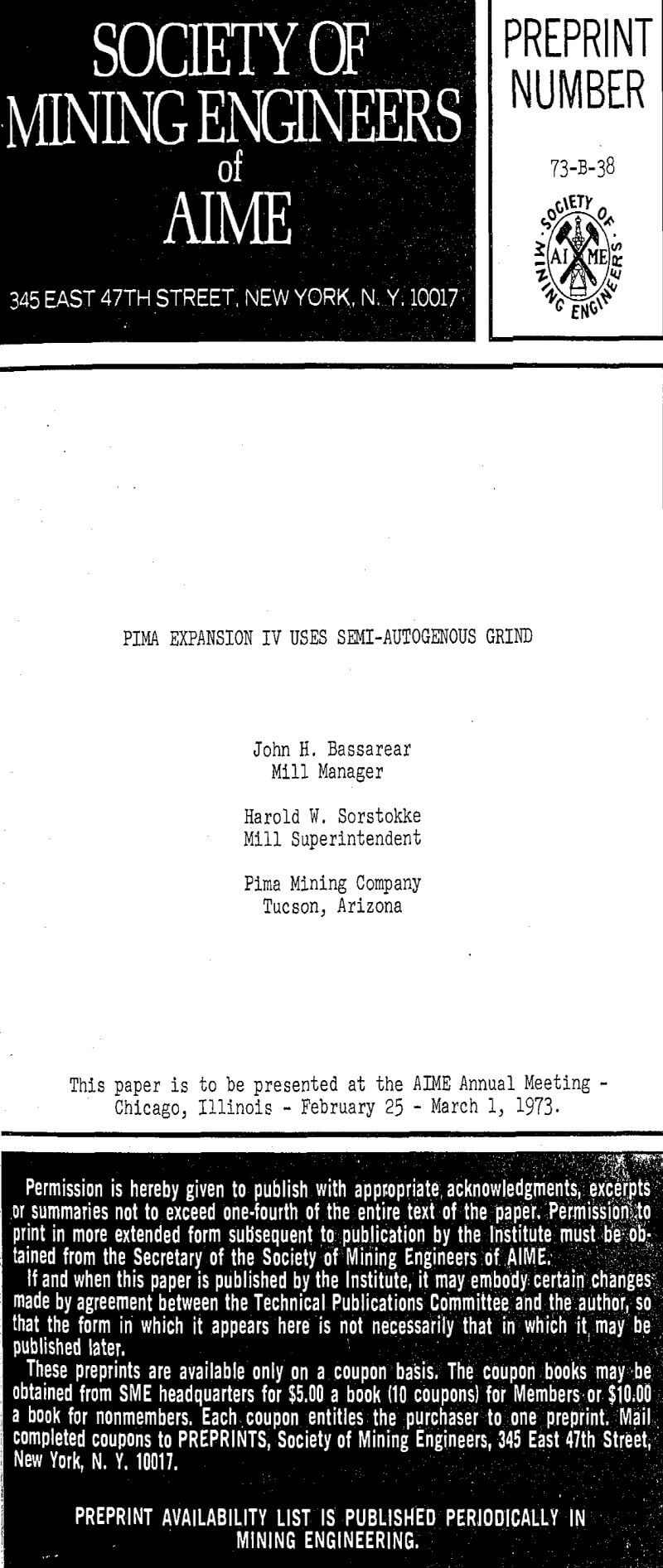The never ending search for lower unit costs led Pima Mining Company’s management to study various alternatives shortly after Expansion III was completed. It soon became apparent that a considerable amount of ore assaying 0.35% copper had to be moved in order to maintain mill feed at the desired 0.54% copper content.
New Mill Flowsheet
A completely new and separate primary crusher was constructed for Expansion IV. The new primary is identical with the existing one except that the crusher discharge is fed to a Barber-Green radial stacker conveyor that can serve both the old mill stockpile and the new mill stockpile.
The minus eight-inch primary crusher product is reclaimed from the stockpile by four 42′ wide by 12′ long NICO pan feeders. The grinding circuit consists of two identical sections that can be used as separate circuits or combined.
Pan feeder discharge is conveyed directly to the two 28′ diameter by 12′ long Koppers semi-autogenous mills. Each mill is driven by dual 3,000 HP wound rotor motors through Falk reducers, resulting in a total connected horsepower of 6,000. Mill speed is 10.95 rpm. or 75% of critical. Mills are loaded with 6-8% by volume of 4″ forged steel grinding balls. The mill discharges, at 60% solids, to a 6′ x 14′ Tyler double deck vibrating screen equipped with 1″ and ½” square space screens. Oversize from both decks is conveyed to a common recycle conveyor that receives screen oversize from both semi-autogenous mills.
Pilot Plant Work
The Pima orebody contains five basic ore types that vary widely in both hardness and dissemination of mineral. Varying grinds are required for good liberation as well as good economics. All five ore types were extensively tested. The harder ores responded best but, primarily by varying ball, size and ball charge, acceptable grinds were obtained even with the softer ores.
Steel consumption, for both liners and balls, was difficult to measure for short test periods. The most accurate measurement of steel consumption seemed to be to average the actual use of steel over the entire six month test period. Liners were weighed at the beginning and end of the test and accurate records were maintained of all balls used. Average total steel consumption during the six-month pilot plant test was about 1.5 lbs./ton. Actual results for the eight months the full scale plant has operated are almost 0.5 lbs./ton higher than this.
Semi-Autogenous Mill
The semi-autogenous mills have 36 grates on the discharge periphery. Grate openings were 3/8″ wide and this was far too small. We have tested ½”, 5/8″ and 7/8″. All are satisfactory but 5/8″ will probably become standard. Each grate was equipped with a 2-½” square ball reject port to remove worn balls as they become too small to be effective. The ports were too large and too numerous. Size has been changed to 1-½” square with only two per quadrant.
During the early part of the year, including March, the ore fed to the semi-autogenous mill was exclusively hard low grade with a work index of about 20. Since March, both mills have been fed the same ore averaging about 17.0 work index.
Operating time for the first year or so was expected to be only 75 – 80% since so much time would be spent down for inspection and evaluation and learning how to decrease liner replacement time. Actual operating time has been very gratifying at 85% for the first eight months of 1972. It is expected that by the end of another year operating time should exceed 90 – 91%. Operating time in the conventional mill usually averages about 97%.
Design capacity of the new circuit was exceeded early in the year. The 14,000 TPD design rate was surpassed as early as March 3, 1972 (16,829 TPD). However, it was May (16,993 TPD) before design tonnage was exceeded for a monthly period. Capacities as high as 23,342 TPD have been achieved with the softer ores but other circuit limitations have kept daily grinding rate in the 17,000 TPD range.




